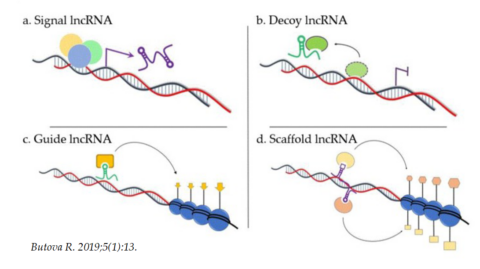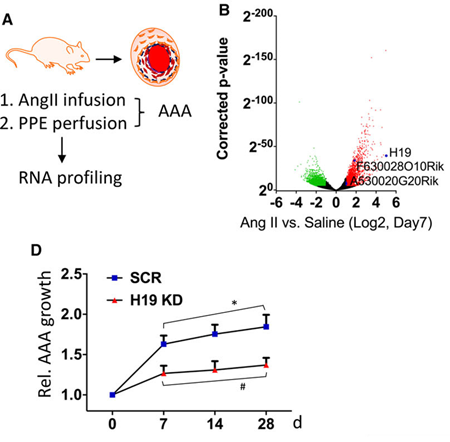The role of non-coding RNAs in vascular disease
Non-coding RNAs (ncRNAs) are ribonucleic acid sequences “not coding” for proteins. Only DNA transcription takes place, the ncRNA is however further processed as mRNA.
The state-of-the-art “next-generation sequencing” revealed that 70 – 80% of the entire genome is translated into RNA, but less than 2% are coding for proteins [Leeper 2018]. These ncRNAs were first thought as “junk-RNA”. Further analyses showed however that they possess important regulatory functions in different cellular processes and development. Dependent upon their length, they can be divided in: (1) small non-coding microRNAs (miRNAs) (<200 bp) and (2) long non-coding RNAs (lncRNAs) (<200 bp), including circular RNAs (circRNAs).
Our results and also of other researchers demonstrated significant differences in the expression of miRNAs in different stages of atherosclerosis, cardiomyopathies and aneurysm, involved in apoptotic signalling pathways of smooth muscle and endothelial cells, neovascularization, inflammation and other pathophysiological changes within the vessel wall [Xu 2019, Yin 2019, Li 2018, Xu 2018, Jin 2018, Eken 2017].
Furthermore, ncRNAs are not only regulatory elements but are also involved in the regulation of hetero- and euchromatin and thus in epigenetics. MiRNAs and lncRNAs regulate DNA and histone methylation, expression of methyl- and acetyltransferases [Frías-Lasserre 2017]. In this way, ncRNAs and epigenetics work closely together.

Figure. Non-coding RNA H19 overexpressed in abdominal aortic aneurysm (AAA). (a) Aortic tissue was collected from two AAA models: (i) ApoE−/− mice using Angiotensin II (AngII); (ii) porcine pancreatic elastase (PPE)-induced AAA was performed in C57BL/6J mice. (b) Volcano plot of deregulated transcripts in the AngII- AAA model. (d) Relative diameter of aortas at baseline, and after 7, 14 and 28 days post-aneurysm induction. In vivo knockdown of H19 was performed by utilizing site-specific antisense oligonucleotides (LNA-GapmeRs, H19 KD) or scrambled oligo controls [Li 2018].
- Xu S, Kamato D, Little PJ, Nakagawa S, Pelisek J, Jin ZG. Targeting epigenetics and non-coding RNAs in atherosclerosis: from mechanisms to therapeutics. Pharmacol Ther. 2019;196:15-43.
- Yin C, Ackermann S, Ma Z, Mohanta SK, Zhang C, Li Y, Nietzsche S, Westermann M, Peng L, Hu D, Bontha SV, Srikakulapu P, Beer M, Megens RTA, Steffens S, Hildner M, Halder LD, Eckstein HH, Pelisek J, Herms J, Roeber S, Arzberger T, Borodovsky A, Habenicht L, Binder CJ, Weber C, Zipfel PF, Skerka C, Habenicht AJR. ApoE attenuates unresolvable inflammation by complex formation with activated C1q. Nat Med. 2019;25(3):496-506.
- Leeper NJ, Maegdefessel L. Non-coding RNAs: key regulators of smooth muscle cell fate in vascular disease. Cardiovasc Res. 2018;114(4):611-621.
- Li DY, Busch A, Jin H, Chernogubova E, Pelisek J, Karlsson J, Sennblad B, Liu S, Lao S, Hofmann P, Bäcklund A, Eken SM, Roy J, Eriksson P, Dacken B, Ramanujam D, Dueck A, Engelhardt S, Boon RA, Eckstein HH, Spin JM, Tsao PS, Maegdefessel L. H19 Induces Abdominal Aortic Aneurysm Development and Progression. Circulation. 2018;138(15):1551-1568.
- Xu S, Pelisek J, Jin ZG. Atherosclerosis is an epigenetic disease. Trends Endocrinol Metab. 2018;S1043-2760(18)30090-0.
- Xu S, Xu Y, Yin M, Zhang S, Liu P, Koroleva M, Si S, Little PJ, Pelisek J, Jin ZG. Flow-dependent epigenetic regulation of IGFBP5 expression by H3K27me3 contributes to endothelial anti-inflammatory effects. Theranostics. 2018;8(11):3007-3021.
- Jin H, Li DY, Chernogubova E, Sun C, Busch A, Eken SM, Saliba-Gustafsson P, Winter H, Winski G, Raaz U, Schellinger IN, Simon N, Hegenloh R, Matic LP, Jagodic M, Ehrenborg E, Pelisek J, Eckstein HH, Hedin U, Backlund A, Maegdefessel L. Mol Ther. Local Delivery of miR-21 Stabilizes Fibrous Caps in Vulnerable Atherosclerotic Lesions. 2018;26(4):1040-1055.
- Frías-Lasserre D, Villagra CA. The Importance of ncRNAs as Epigenetic Mechanisms in Phenotypic Variation and Organic Evolution. Front Microbiol. 2017;8:2483.
- Eken SM, Jin H, Chernogubova E, Li Y, Simon N, Sun C, Korzunowicz G, Busch A, Bäcklund A, Österholm C, Razuvaev A, Renné T, Eckstein HH, Pelisek J, Eriksson P, González Díez M, Perisic Matic L, Schellinger IN, Raaz U, Leeper NJ, Hansson GK, Paulsson-Berne G, Hedin U, Maegdefessel L. MicroRNA-210 Enhances Fibrous Cap Stability in Advanced Atherosclerotic Lesions. Circ Res. 2017;120(4):633-644.
- Pelisek J, Eckstein HH, Zernecke A. (2012) Pathophysiological mechanisms of carotid plaque vulnerability: impact on ischemic stroke. Arch Immunol Ther Exp. 2012;60(6):431-442.